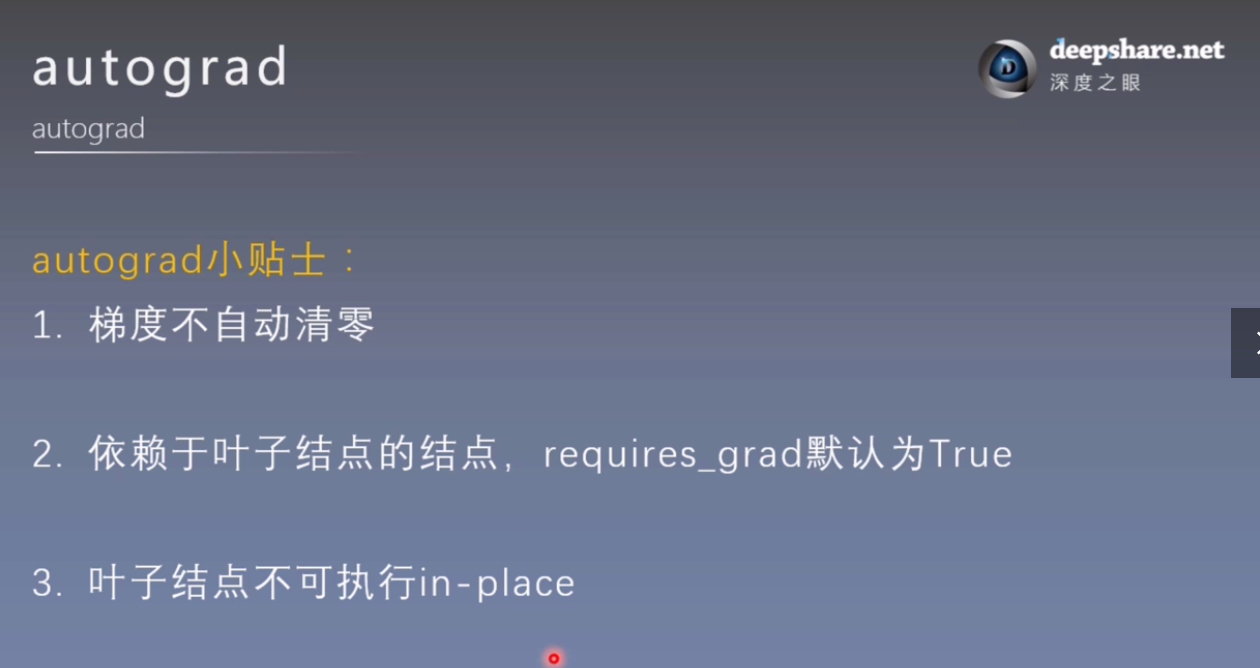【笔记】PyTorch框架学习 -- 2. 计算图、autograd以及逻辑回归的实现
1. 计算图
使用计算图的主要目的是使梯度求导更加方便。




import torch
w = torch.tensor([1.], requires_grad=True)
x = torch.tensor([2.], requires_grad=True)
a = torch.add(w, x) # retain_grad()
b = torch.add(w, 1)
y = torch.mul(a, b)
y.backward()
print(w.grad) # tensor([5.])
# 查看叶子结点
print("is_leaf:\n", w.is_leaf, x.is_leaf, a.is_leaf, b.is_leaf, y.is_leaf)
# is_leaf: True True False False False
# 查看梯度
print("gradient:\n", w.grad, x.grad, a.grad, b.grad, y.grad)
# gradient: tensor([5.]) tensor([2.]) None None None
# 查看 grad_fn
print("grad_fn:\n", w.grad_fn, x.grad_fn, a.grad_fn, b.grad_fn, y.grad_fn)
# grad_fn:
# None
# None
# <AddBackward0 object at 0x00000258F55C28D0>
# <AddBackward0 object at 0x00000258F55C2A58>
# <MulBackward0 object at 0x00000258F55D5518>
2. 静态图和动态图
TensorFlow是静态图,PyTorch是动态图,区别在于在运算前是否先搭建图。

3. autograd 自动求导

import torch
torch.manual_seed(10)
# 非叶子节点默认不保存梯度,除非显式指定
w = torch.tensor([1.], requires_grad=True)
x = torch.tensor([2.], requires_grad=True)
a = torch.add(w, x)
b = torch.add(w, 1)
y = torch.mul(a, b)
# 如果不保存图,那么不能执行第二次
y.backward(retain_graph=True)
print(w.grad) # tensor([5.])
y.backward()
grad_tensors的使用:
w = torch.tensor([1.], requires_grad=True)
x = torch.tensor([2.], requires_grad=True)
a = torch.add(w, x) # retain_grad()
b = torch.add(w, 1)
y0 = torch.mul(a, b) # y0 = (x+w) * (w+1)
y1 = torch.add(a, b) # y1 = (x+w) + (w+1) dy1/dw = 2
loss = torch.cat([y0, y1], dim=0) # [y0, y1]
print(loss) # tensor([6., 5.], grad_fn=<CatBackward>)
grad_tensors = torch.tensor([1., 2.])
loss.backward(gradient=grad_tensors) # gradient 传入 torch.autograd.backward()中的grad_tensors
print(w.grad) # tensor([9.])

x = torch.tensor([3.], requires_grad=True)
y = torch.pow(x, 2) # y = x**2
# 只有创建了导数的计算图,才能进行二阶求导
grad_1 = torch.autograd.grad(y, x, create_graph=True) # grad_1 = dy/dx = 2x = 2 * 3 = 6
print(grad_1) # (tensor([6.], grad_fn=<MulBackward0>),)
grad_2 = torch.autograd.grad(grad_1[0], x) # grad_2 = d(dy/dx)/dx = d(2x)/dx = 2,二阶导数
print(grad_2) # (tensor([2.]),)

# 1. 梯度不自动清零
w = torch.tensor([1.], requires_grad=True)
x = torch.tensor([2.], requires_grad=True)
for i in range(4):
a = torch.add(w, x)
b = torch.add(w, 1)
y = torch.mul(a, b)
y.backward()
print(w.grad) # 若未清零,tensor([5.]) tensor([10.]) tensor([15.]) tensor([20.])
w.grad.zero_() # 若清零了,tensor([5.]) tensor([5.]) tensor([5.]) tensor([5.])
# 2. 依赖叶子节点的节点,requires_grad默认为True
w = torch.tensor([1.], requires_grad=True)
x = torch.tensor([2.], requires_grad=True)
a = torch.add(w, x)
b = torch.add(w, 1)
y = torch.mul(a, b)
print(a.requires_grad, b.requires_grad, y.requires_grad) # True True True
# 查看下地址
a = torch.ones((1, ))
print(id(a), a) # 2158573461368 tensor([1.])
# a = a + torch.ones((1, ))
# print(id(a), a) # 1939675405912 tensor([2.]) 地址换了
a += torch.ones((1, ))
print(id(a), a) # 2158573461368 tensor([2.])
#===========================================
# 3. 叶子节点不能in-place操作
w = torch.tensor([1.], requires_grad=True)
x = torch.tensor([2.], requires_grad=True)
a = torch.add(w, x)
b = torch.add(w, 1)
y = torch.mul(a, b)
w.add_(1) # in-place操作,会报错
y.backward()
4. 逻辑回归



import torch
import torch.nn as nn
import matplotlib.pyplot as plt
import numpy as np
torch.manual_seed(10)
# ============================ step 1/5 生成数据 ============================
sample_nums = 100
mean_value = 1.7
bias = 1
n_data = torch.ones(sample_nums, 2)
x0 = torch.normal(mean_value * n_data, 1) + bias # 类别0 数据 shape=(100, 2)
y0 = torch.zeros(sample_nums) # 类别0 标签 shape=(100, 1)
x1 = torch.normal(-mean_value * n_data, 1) + bias # 类别1 数据 shape=(100, 2)
y1 = torch.ones(sample_nums) # 类别1 标签 shape=(100, 1)
train_x = torch.cat((x0, x1), 0)
train_y = torch.cat((y0, y1), 0)
# ============================ step 2/5 选择模型 ============================
class LR(nn.Module):
def __init__(self):
super(LR, self).__init__()
self.features = nn.Linear(2, 1)
self.sigmoid = nn.Sigmoid()
def forward(self, x):
x = self.features(x)
x = self.sigmoid(x)
return x
lr_net = LR() # 实例化逻辑回归模型
# ============================ step 3/5 选择损失函数 ============================
loss_fn = nn.BCELoss()
# ============================ step 4/5 选择优化器 ============================
lr = 0.01 # 学习率
optimizer = torch.optim.SGD(lr_net.parameters(), lr=lr, momentum=0.9)
# ============================ step 5/5 模型训练 ============================
for iteration in range(1000):
# 前向传播
y_pred = lr_net(train_x)
# 计算 loss
loss = loss_fn(y_pred.squeeze(), train_y)
# 反向传播
loss.backward()
# 更新参数
optimizer.step()
# 清空梯度
optimizer.zero_grad()
# 绘图
if iteration % 20 == 0:
mask = y_pred.ge(0.5).float().squeeze() # 以0.5为阈值进行分类
correct = (mask == train_y).sum() # 计算正确预测的样本个数
acc = correct.item() / train_y.size(0) # 计算分类准确率
plt.scatter(x0.data.numpy()[:, 0], x0.data.numpy()[:, 1], c='r', label='class 0')
plt.scatter(x1.data.numpy()[:, 0], x1.data.numpy()[:, 1], c='b', label='class 1')
w0, w1 = lr_net.features.weight[0]
w0, w1 = float(w0.item()), float(w1.item())
plot_b = float(lr_net.features.bias[0].item())
plot_x = np.arange(-6, 6, 0.1)
plot_y = (-w0 * plot_x - plot_b) / w1
plt.xlim(-5, 7)
plt.ylim(-7, 7)
plt.plot(plot_x, plot_y)
plt.text(-5, 5, 'Loss=%.4f' % loss.data.numpy(), fontdict={'size': 20, 'color': 'red'})
plt.title("Iteration: {}\nw0:{:.2f} w1:{:.2f} b: {:.2f} accuracy:{:.2%}".format(iteration, w0, w1, plot_b, acc))
plt.legend()
plt.show()
plt.pause(0.5)
if acc > 0.99:
break
最终结果:

思考:
- 调整线性回归模型停止条件以及y = 2*x + (5 + torch.randn(20, 1))中的斜率,训练一个线性回归模型;
- 计算图的两个主要概念是什么?
- 动态图与静态图的区别是什么?
- 逻辑回归模型为什么可以进行二分类?
- 采用代码实现逻辑回归模型的训练,并尝试调整数据生成中的mean_value,将mean_value设置为更小的值,例如1,或者更大的值,例如5,会出现什么情况?
- 再尝试仅调整bias,将bias调为更大或者负数,模型训练过程是怎么样的?




